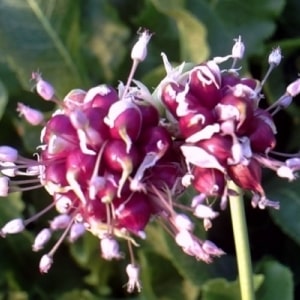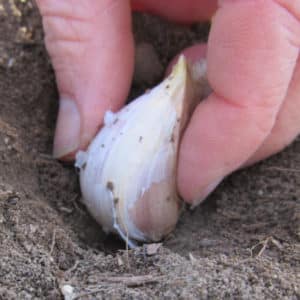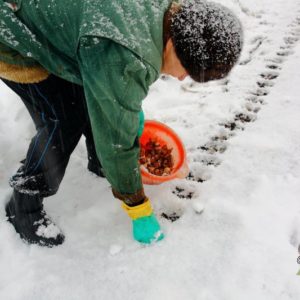Step-by-step instructions for planting garlic bulbs before winter: basic rules and secrets of experienced gardeners
Few people know that planting garlic bulbs before winter is the most economical and at the same time productive method of growing the plant. Winter varieties are also propagated by seeds and cloves, but this consumes more material. The method of planting bulbs is labor-intensive, but it allows you to preserve all the beneficial properties of the plant and protect it from diseases.
Garlic bulbs - what are they?
Bulbs are small cloves of garlic that form at the very top of the bulb in a translucent box. They appear in early summer and are often removed by summer residents as unnecessary.
 The presented photo shows what a box with air bulbs looks like.
The presented photo shows what a box with air bulbs looks like.
These are the vegetative organs of the plant that take part in the reproduction process of garlic. Some gardeners call them seeds. This is not entirely correct from a botanical point of view, since the plant does not bloom. However, this definition is often used among summer residents.
Why use bulbs
Garlic is grown from bulbs to prevent the variety from degenerating. If you grow a plant from cloves for 3-4 years, each year the heads will be smaller in size and weight than the previous ones. They are also more susceptible to fungal diseases. As a result, the variety loses its positive qualities and becomes unsuitable for planting (degenerates).
Attention! From the bulb grows one bulb weighing no more than 7 g, it is called one-toothed.After planting it, next summer you will get a large head of garlic.
Cultivation of garlic from heads is associated with frequent plant diseases. A common pest is the stem nematode, which damages the head during its formation. This parasite does not touch the bulb, so the gardener receives high-quality seed from it.
This planting saves the gardener’s finances. If you take 1 head of the winter variety, you will get about 10 cloves for subsequent planting. The bulb contains about a hundred of them. When planted next year, they will produce 100 cloves, and after another 12 months - 100 large heads of high-quality garlic.
How to grow and collect bulbs
The process of growing bulbs is simple. They form independently on the stem of a winter variety of garlic. After the ovary appears on the shoot, you should wait until a box with airy “seeds” forms and the protective translucent film on it bursts. After this, the shoots are cut and dried for 10 days.
It is best to do this 1-1.5 months before the intended planting. In the middle zone, this period falls on the month of September-October.
How to store and sort
There is no need to create special conditions for storing bulbs. They tolerate temperatures of around 15 degrees Celsius well throughout the winter. About 2 months before the intended planting, it is necessary to transfer the “seeds” to a cool place.
It is ideal for subsequent storage to maintain a temperature of no higher than 5 degrees Celsius. Under such conditions, natural hardening of the bulbs occurs. It is recommended to sort aerial “seeds” by diameter (large, medium and small).After the soil warms up to +7 degrees, they can be planted at a distance of 5-6 cm from each other.
Timing for planting winter garlic in the fall
When to plant winter garlic directly depends on the characteristics of the climate zone. In the middle zone, it is recommended to do this approximately 14-21 days before frost. This time is enough for the plant to take root. In three weeks, the garlic will form a root system, but the above-ground green part will not hatch yet.
The open ground temperature should be approximately +10-12°C. Lower values are also allowed, but it is forbidden to plant garlic in frozen ground.
If we make a distribution by region, then the planting dates are as follows:
- The middle zone is from late September to mid-October.
- Southern regions - from late October to late November.
- Northern regions - from the second half of September to mid-October.
Experienced gardeners independently determine the optimal time for planting garlic, focusing on weather conditions.
Is it possible to plant garlic bulbs in the spring?
You can plant garlic bulbs in the spring, and then leave them in the ground throughout the winter. If the plant is not dug up, it will need to be thinned out so that large heads of garlic will form next year.
It is best to plant the bulbs in the spring, and dig them up in the fall and leave them for storage in a room with a temperature no higher than +15° C. The next year, the “seeds” require replanting to a permanent place. It is important to maintain an interval between “seeds” of 5-6 cm.
Growing garlic from bulbs in open ground
Novice gardeners hardly know how to plant garlic from bulbs in open ground correctly in order to get a high-quality harvest.Aerial “seeds” are placed in the ground in the spring. Around the beginning of August or end of July, the leaves of the plant will begin to turn yellow. Until the part located above the ground has dried out, the heads of garlic are dug up.
Advice. The vegetable should be left in the shade and wait until the husks begin to separate from the stem on their own, then tie them into bunches and hang them in the attic or barn.
Already in the fall, according to recommendations regarding the climate in the region, one-toothed garlic is planted in the garden. In the summer, arrows will appear from the seedlings, and in August boxes with bulbs will appear. It is important to consider all the “seeds” and evaluate their quality. Good garlic grows from healthy, large-sized bulbs, without darkening, rotting or mold.
Preparing land and beds for autumn planting of garlic
With this growing technology, the crop becomes particularly demanding on the composition of the soil.
To get a good harvest, three conditions must be met:
- Prepared soil.
- Healthy and hardened seed.
- Careful care of the beds.
The soil in the area where it is planned to grow garlic is dug up. In the process, weeds and remnants of their roots are removed.
Preparation of planting material
Before sowing, the bulbs must be prepared. Initially, the “seeds” are hardened. To do this, they are placed in the refrigerator, where the temperature is maintained at 3-5 degrees, for 20-30 days. To carry out disinfection, planting material is treated with a 1% concentration of copper sulfate solution.
Initially, the “seeds” are soaked for 2 minutes in a solution of table salt (3 tablespoons per 5 liters of water), then transferred to a container with copper sulfate (1 teaspoon of the substance is diluted in 10 liters of water).The future garlic is left in the liquid for 30 minutes, then taken out and dried. Now the “seeds” are ready for planting.
How to plant
Prepared and carefully sorted garlic bulbs are planted in rows. The row width should be approximately 10 cm. Large-sized “seeds” are laid out at a distance of 4 cm from each other. 3-4 dozen bulbs are planted per 1 m².

It is not recommended to plant garlic in places where tomatoes or potatoes previously grew. After these crops, the risk of Fusarium infection increases.
It is better to choose a plot of land where pumpkin, cabbage, beans, beans, alfalfa or mustard grew. The laid out bulbs are carefully sprinkled with soil, but not compacted, and watered.
In autumn it is recommended to feed the soil. For 1 m², take a mixture of 5 kg of humus, 30 g of superphosphate and 20 g of potassium chloride. If the soil has an acidic pH, lime it. Limestone ground into flour is suitable for this purpose. Before planting the bulblets, 0.3-0.5 kg of limestone per 1 m² is added to the rows.
Practical experience in growing garlic from bulbs
Many gardeners have extensive experience growing garlic from bulbs. But the works of Andrei Aleksandrovich Panin, a gardener from Kuban, deserve special attention. His technology was described in one of the specialized magazines in 1997. He developed a method for growing commercial garlic bulbs in the second year by obtaining large bulbs.
Andrei Aleksandrovich grew garlic in aluminum tubes no more than 4.5 cm long. He put the clove on one side and immersed the other in the ground. In the spring, one could observe the appearance of arrows.The essence of the technique is that due to the limited diameter of the tube, the head of garlic does not grow large, and the plant uses all its strength in arrows.
After the garlic leaves have turned yellow and the shell of the box with the bulbs is almost cracked, the arrows are cut off. For subsequent ripening, they are hung in the form of small sheaves in the shade. After about a month, the husks are removed from the “seeds” and only those bulbs that are at least the size of a bean are selected for planting. Otherwise, the process of hardening, planting and harvesting is standard.
Pros and cons of the method
Like most agricultural technologies, growing garlic from bulbs has its own disadvantages and advantages. Among the advantages the following is noted:
- the ability to independently grow planting material;

- preservation, renewal and rejuvenation of garlic varieties;
- obtaining healthy “seeds”;
- direct sowing of bulbs in open ground;
- easy care during growth period.
The main disadvantage of the method is that to obtain a harvest you will have to wait two growing seasons. In the first year they get single teeth, and only in the next year they get full heads.
With the early onset of winter, the likelihood of planting material freezing increases.
Some useful tips from experienced gardeners
Gardeners with extensive practical experience in growing this crop recommend listening to the following advice:
- Leave arrows on those bushes that have formed large heads.
- Harvest the heads along with the arrows.
- You can plant garlic from bulbs in spring and autumn, but it is better to give preference to the first option in order to prevent the seeds from freezing.
- Carefully discard any glassy or dried out bulbs before planting.
- Dig up the cloves around mid-August.
Garlic is a crop that does not require specific care. After the seedlings have appeared, you need to apply fertilizer and water the soil.
Read also:
How to properly plant garlic before winter?
Onion garlic or hair onion - what is Rocambole garlic?
What to plant after garlic next year, and what crops should be avoided.
Conclusion
Growing garlic from aerial “seeds” is an ideal technique for preserving the plant variety and preventing its infection by viruses, fungi or bacteria. However, to obtain a decent harvest, it is necessary to strictly follow agricultural technology, so inexperienced gardeners often abandon this planting technique.